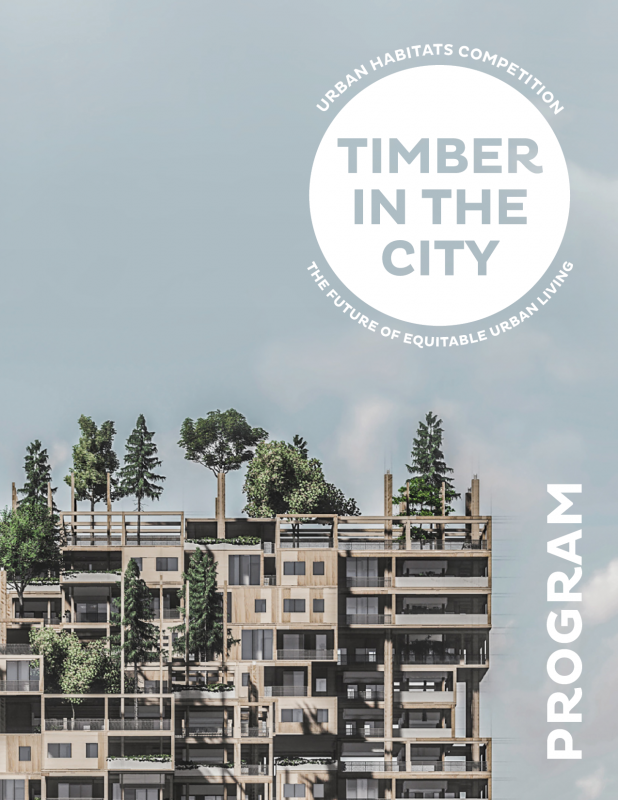Resources
Entrants are encouraged to research references that are related to both the topic of the competition and precedent projects that demonstrate innovative use of timber such as those listed below. An intention of all ACSA competitions is to make students aware that research is a fundamental element of any design solution.
Wood Technology
- Think Wood Research Library
- WoodProducts Council
- US Forest Products Laboratory – Product & Building Systems Research
- FPInnovations – Product & Building Systems Research
- American Wood Council – Codes & Standards Support
- naturally:wood
- CLT Handbook
- Timber in the City – Andrew Bernheimer
- Mass Timber: Design & Research – Susan Jones
- The Case For Tall Wood Buildings: Second Edition– Michael Green
Thermal Comfort and Bioclimatic Design
- American Institute of Architects (AIA) Research Corporation, United States. Dept. of Energy, and United States. Dept. of Housing and Urban Development. Office of Policy Development and Research. Regional Guidelines for Building Passive Energy Conserving Homes. Washington: U.S. Dept. of Housing and Urban Development: for sale by the Supt. of Docs., U.S. Govt. Print. Off., 1978. Web. (Georgia Tech library online access)
- Brew, James. “Achieving Passivhaus Standard in North America: Lessons Learned.” ASHRAE Transactions 117 (2011): 51-58. Web. (Georgia Tech library online access)
- Edelstein, Ken. The site, the shade and passive solar. August 16, 2017. Web. Retrieved 7-17-19 10:35PM. LINK
- Gibson, Scott. “Does Passivhaus work in New Orleans?” in Green Building Advisor 7/18/2011. Retrieved 7/20/2019 1:22 PM LINK
- Hootman, Thomas. Net Zero Energy Design a Guide for Commercial Architecture. Hoboken, N.J.: John Wiley & Sons, 2012. Web. (Georgia Tech library online access)
- Knowles, Ralph L. Sun Rhythm Form. Cambridge, Mass.: MIT, 1981. Print.
- Koti, Ramana & Feucht, Alissa. (2013). Opportunities and Challenges in Employing Energy Analysis Early in the Integrated Design Process. 42nd ASES National Solar Conference 2013
- (SOLAR 2013). Conference Paper 2013. LINK
- Lechner, Norbert, and C. Wallace. Heating, Cooling, Lighting: Sustainable Design Methods for Architects. Fourth ed. 2015. Web. (Georgia Tech library online access)
- Mazria, Edward. The Passive Solar Energy Book. Expanded Professional ed. Emmaus, Pa.: Rodale, 1979. Print.
- Milne, Murray, Liggett, Robin, Benson, Andrew, & Bhattacharya, Yasmin. UCLA Department of Architecture and Urban Design. Climate Consultant 4.0 Develops Design Guidelines for Each Unique Climate. American Solar Energy Society, Buffalo, New York, May, 2009. LINK
- Ness, H.C. Van. Understanding Thermodynamics. Newburyport: Dover Publications, 2012. Dover Books on Physics. Web. (Georgia Tech library online access)
- NIST.SP.1204 (re. weather data files accessible through Climate Consultant software)
- Racusin, Jacob Deva. Essential Building Science: Understanding Energy and Moisture in High Performance House Design. 2016. Sustainable Building Essentials. Web. (Georgia Tech library online access)
- Reinhart, Christoph. Daylighting Handbook I. Cambridge, Ma.:Building Technology Press. 2014. Print.
- 2030 Palette: LINK
Daylighting
- Boubekri, Mohamed. Daylighting Design: Planning Strategies and Best Practice Solutions. 2014. Web. (Georgia Tech library online access)
- Cooper, Kenneth J. “Study Says Natural Classroom Lighting Can Aid Achievement”. In Washington Post. November 26, 1999. LINK
- Heschong Mahone Group, Daylighting in Schools, An Investigation into the Relationship between Daylighting and Human Performance, Condensed Report. Fair Oaks, Ca.: Pacific Gas and electric Company. 1999. LINK
- Konis, Kyle., and Stephen. Selkowitz. Effective Daylighting with High-Performance Facades Emerging Design Practices. 2017. Green Energy and Technology. Web. (Georgia Tech library online access)
- Lechner, Norbert, and C. Wallace. Heating, Cooling, Lighting: Sustainable Design Methods for Architects. Fourth ed. 2015. Web. (Georgia Tech library online access)
- Reinhart, Christoph. Daylighting Handbook I. Cambridge, Ma: Building Technology Press. 2014. Print.
- Reinhart, Christoph. Daylighting Handbook II. Cambridge, MA: Building Technology Press. 2018. Print.
Competition Sponsor
The Softwood Lumber Board is an industry-funded initiative established to promote the benefits and uses of softwood lumber products in outdoor, residential, and non-residential construction and to increase demand for softwood lumber and appearance products. Through strategic investments in pro-wood communications, standards development, design and engineering assistance, research, demonstrations and partnerships, the organization seeks to make softwood lumber the preferred material choice from both an economic and an environmental standpoint.
Host
Architecture was established as a discipline of study at Georgia Tech in 1908 at the request of a civil engineering student who recruited fellow students for an entering class of twenty. Over the intervening century, the Department of Architecture has been complemented by the addition of disciplines (in order of establishment) of Industrial Design (1940), City & Regional Planning (1952), Building Construction (1958), and Music (1991).
The multi-disciplinary College of Architecture (now called the College of Design) was established in 1975, and a significant milestone that soon followed was the establishment in 1982 of the Doctor of Philosophy in Architecture degree and the multi-disciplinary Doctoral Program, a reflection of the increasing complexity of the designed and built environment as well as the growing emphasis upon leading-edge research at Georgia Tech.
The Georgia Institute of Technology announced on Earth Day 2021 that The Kendeda Building for Innovative Sustainable Design earned Living Building Challenge certification, the world’s most ambitious and holistic green building achievement. The certification from the International Living Future Institute independently verifies that The Kendeda Building is among the greenest in the world. Rather than being less bad than conventional buildings, The Kendeda Building proved over a 12-month performance period that it is regenerative. It gives back more than it takes from the environment and focuses on the health and happiness of occupants.
Competition Organizer

Association of Collegiate Schools of Architecture (ACSA)
Leading Architectural Education and Research
ACSA is a nonprofit, membership association founded in 1912 to advance the quality of architectural education. The school membership in ACSA has grown from 10 charter members to over 250 schools in several membership categories. These include full membership for all accredited programs in the United States and government-sanctioned schools in Canada, candidate membership for schools seeking accreditation, and affiliate membership for schools for two-year and international programs. Through these schools, over 5,000 architecture faculty members are represented. In addition, over 500 supporting members composed of architecture firms, product associations and individuals add to the breadth of interest and support of ACSA goals. ACSA provides a major forum for ideas on the leading edge of architectural thought. Issues that will affect the architectural profession in the future are being examined today in ACSA member schools.
Questions
Edwin Hernández
Programs Coordinator
ehernandez@acsa-arch.org
202.785.2324
Eric W. Ellis
Senior Director of Operations and Programs
202-785-2324
eellis@acsa-arch.org

 Study Architecture
Study Architecture  ProPEL
ProPEL 


